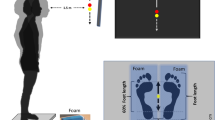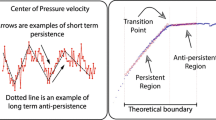Abstract
Stabilogram-diffusion analysis was used to examine how prolonged periods in microgravity affect the open-loop and closed-loop postural control mechanisms. It was hypothesized that following spaceflight: (1) the effective stochastic activity of the open-loop postural control schemes in astronauts is increased; (2) the effective stochastic activity and uncorrelated behavior, respectively, of the closed-loop postural control mechanisms in astronauts are increased; and (3) astronauts utilize open-loop postural control schemes for shorter time intervals and smaller displacements. Four crew members and two alternates from the 14-day Spacelab Life Sciences 2 Mission were included in the study. Each subject was tested under eyes-open, quiet-standing conditions on multiple preflight and postflight days. The subjects' center-of-pressure trajectories were measured with a force platform and analyzed according to stabilogram-diffusion analysis. It was found that the effective stochastic activity of the open-loop postural control schemes in three of the four crew members was increased following space-flight. This result is interpreted as an indication that there may be in-flight adaptations to higher-level descending postural control pathways, e.g., a postflight increase in the tonic activation of postural muscles. This change may also be the consequence of a compensatory (e.g., “stiffening”) postural control strategy that is adopted by astronauts to account for general feelings of post-flight unsteadiness. The crew members, as a group, did not exhibit any consistent preflight/postflight differences in the steady-state behavior of their closed-loop postural control mechanisms or in the functional interaction of their open-loop and closed-loop postural control mechanisms. These results are interpreted as indications that although there may be in-flight adaptations to the vestibular system and/or proprioceptive system, input from the visual system can compensate for such changes during undisturbed stance.
Similar content being viewed by others
References
Andersen DJ, Reschke MF, Homick JE, Werness SAS (1986) Dynamic posture analysis of Spacelab-1 crew members. Exp Brain Res 64: 380–391
Collins JJ, De Luca CJ (1993) Open-loop and closed-loop control of posture: a random-walk analysis of center-of-pressure trajectories. Exp Brain Res 95: 308–318
Collins JJ, De Luca CJ (1994) Random walking during quiet standing. Physical Rev Lett 73: 764–767
Collins JJ, De Luca CJ (1995a) The effects of visual input on open-loop and closed-loop postural control mechanisms. Exp Brain Res 103: 151–163
Collins JJ, De Luca CJ (1995b) Upright, correlated random walks: a statistical-biomechanics approach to the human postural control system. CHAOS 5: 57–63
De Luca CJ, LeFever RS, McCue MP, Xenakis AP (1982) Control scheme governing concurrently active human motor units during voluntary contractions. J Physiol (Lond) 329: 129–142
Feder J (1988) Fractals. Plenum, New York
Homick JL, Reschke MF (1977) Postural equilibrium following exposure to weightless space flight. Acta Otolaryngol 83: 455–464
Homick JL, Reschke MF, Miller EF (1977) The effects of prolonged exposure to weightlessness on postural equilibrium. In: Biomedical results from Skylab. NASA SP-377:104–112
Joyce GC, Rack PMH (1974) The effects of load and force on tremor at the normal human elbow joint. J Physiol (Lond) 240: 375–396
Kenyon RV, Young LR (1986) M.I.T./Canadian vestibular experiments on the Spacelab-1 mission. 5. Postural responses following exposure to weightlessness. Exp Brain Res 64: 335–346
Kozlovskaya IB, Kreidich YV, Oganov VS, Koserenko OP (1981a) Pathophysiology of motor functions in prolonged manned space flights. Acta Astronautica 8: 1059–1072
Kozlovskaya IB, Kreidich YV, Rakhmanov AS (1981b) Mechanisms of the effects of weightlessness on the motor system of man. Physiologist [Suppl] 24: 59–64
Kozlovskaya IB, Aslanova IF, Grigorieva LS, Kreidich YV (1982) Experimental analysis of motor effects of weightlessness. Physiologist [Suppl] 25: 49–52
Paloski WH, Reschke MF, Black FO, Doxey DD, Harm DL (1992a) Recovery of postural equilibrium control following spaceflight. Ann NY Acad Sci 656: 747–754
Paloski WH, Reschke MF, Doxey DD, Black FO (1992b) Neurosensory adaptation associated with postural ataxia following spaceflight. In: Woollacott M, Horak F (eds) Posture and gait: control mechanisms, vol I. University of Oregon Books, Oregon, pp 311–314
Reschke MF, Andersen DJ, Homick JL (1984) Vestibulospinal reflexes as a function of microgravity. Science 225: 212–214
Roll JP, Popov K, Gurfinkel V, Lipshits M, André-Deshays C, Gilhodes JC, Quoniam C (1993) Sensorimotor and perceptual function of muscle proprioception in microgravity. J Vestib Res 3: 259–273
Saupe D (1988) Algorithms for random fractals. In: Peitgen H-O, Saupe D (eds) The science of fractal images. Springer, New York, pp 71–136
Shrout PE, Fleiss JL (1979) Intraclass correlations: uses in assessing rater reliability. Psychol Bull 86: 420–428
Watt DGD, Money KE, Tomi LM (1986) M.I.T./Canadian vestibular experiments on the Spacelab-1 mission. 3. Effects of prolonged weightlessness on a human otolith-spinal reflex. Exp Brain Res 64: 308–315
Young LR, Oman CM, Watt DGD, Money KE, Lichtenberg BK (1984) Spatial orientation in weightlessness and readaptation to earth's gravity. Science 225: 205–208
Young LR, Oman CM, Watt DGD, Money KE, Lichtenberg BK, Kenyon RV, Arrott AP (1986) M.I.T./Canadian vestibular experiments on the Spacelab-1 mission. 1. Sensory adaptation to weightlessness and readaptation to one-g: an overview. Exp Brain Res 64: 291–298
Author information
Authors and Affiliations
Rights and permissions
About this article
Cite this article
Collins, J.J., De Luca, C.J., Pavlik, A.E. et al. The effects of spaceflight on open-loop and closed-loop postural control mechanisms: human neurovestibular studies on SLS-2. Exp Brain Res 107, 145–150 (1995). https://doi.org/10.1007/BF00228026
Received:
Accepted:
Issue Date:
DOI: https://doi.org/10.1007/BF00228026




